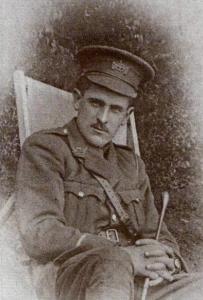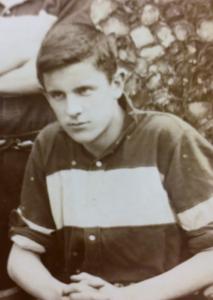
|

|
| 2nd Lieutenant Allan Oswald MILES | |
|
13th (Service) Battalion Gloucestershire Regiment (Forest of Dean) (Pioneers) Date of birth: 6th April 1889 Date of death: 30th June 1916 Killed in action aged 27 Commemorated on the Loos Memorial Panel 60 to 64 |

|
| Allan Oswald Miles was born at Almondsbury in Gloucestershire on the 6th of April 1889 the fourth son of the Reverend Canon Charles Oswald Miles MA Vicar of Almondsbury, and Fanny Jane (nee Ward) Miles of The Vicarage, Almondsbury. He was christened at St Mary's Church, Almondsbury on the 5th of May 1889. His father died in 1898, before he was born, and the family moved to 1 Portland Villas, East Heath Road, Hampstead Heath, London NW3. He was educated at Pembroke Lodge Preparatory School at Southbourne and at Lancing College where he won an Exhibition and was in Seconds House from September 1904 to July 1908. He was wicketkeeper for the Cricket XI in 1907 and 1908, was a member of the Football XI from 1906 to 1908 and won his sports colours in 1908. He served for five years as member of the Officer Training Corps, where he rose to the rank of Sergeant. He was appointed as a Prefect in 1906. He went on to Trinity College Oxford in 1908 where he was an athlete, achieving a BA with Honours in history in 1911 and later a MA. On leaving university he became a school master at his old school of Pembroke Lodge in Southbourne where he was a member of the Officer Training Corps for five years. He was teaching at the school when the war broke out. On the 30th of December 1914 he enlisted at London in the Royal Naval Volunteer Reserve as Ordinary Seaman Z/1173. At a medical examination, which was held on the same day, it was recorded that he was six feet two inches tall with dark brown hair, blue eyes and a medium complexion. He was posted to the Public Schools Battalion, Royal Naval Division, based at Crystal Palace from where he applied for a commission on the 28th of January 1915. He was commissioned as a 2nd Lieutenant in the 11th (Reserve) Battalion Gloucestershire Regiment on the 15th of February 1915. He was posted to the 13th Battalion of his regiment. On the night of the 29th/30th of June 1916, the eve of the great Somme battle, the 13th Battalion Gloucestershire Regiment was to be in support of an attack on German trenches at a position known as the "Boar's Head" to the south east of Richebourg L'Avoue between Neuve Chapelle and Festubert. The attacking battalions were the 12th and 13th Battalions Royal Sussex Regiment who were to take the first and second lines. Accompanying them would be parties of Royal Engineers who were to build machine gun positions in the captured trenches. Immediately behind them would be the Gloucesters in four parties made up of nine officers and 285 men with orders to dig a communication trench between the British and German front lines so that the captured position could be supported. They were also to construct breastworks facing the new German positions. The British artillery fired for three hours on the afternoon of the 29th of June with the intention of cutting the German barbed wire which, in the event, they failed to do in all but a few places. At 2.55am on the 30th there was an intensive bombardment for ten minutes, after which the assault troops launched themselves into no man's land at 3.05am. They captured the first line German trench, with some men getting as far as the second line before a counter bombardment by the German artillery caused too many casualties to continue. Three of the parties of Gloucesters were held up by the uncut German wire and by the shelling but the fourth party, who left their trench five minutes after the men of the Royal Sussex, managed to get to the captured position and begin digging. They had to stop work to drive off German bombers who attacked their left flank and by the time they were able to withdraw at 6am they had completed 115 yards of trench from between two and five feet in depth. Both of the officers who were with them were killed, Allan Miles being shot through the head while tending to a wounded man. Casualties among the fourth party were two officers killed with forty two other ranks killed or wounded. The rest of the battalion lost a further two officers and 5 other ranks killed or wounded. His mother received the following telegram dated the 3rd of July 1916: - "Deeply regret to inform you 2/Lt A.O. Miles Gloucester Regt. was killed in action 30th June. The Army Council express their sympathy." After the battle an officer of the battalion wrote:- "I have been up to the line to see what state it was in, and saw the work our chaps did. It is perfectly marvellous considering the hell of fire of every kind that they were working under. How any men came out of it alive I cannot think." Captain Hugh Jones wrote: - "Although he had only been with us such a short time, he had by his cheerfulness, keenness and ability firmly established himself in the affections of the officers and the respect of the men. He organised the piece of work (in which he met his death) with conspicuous ability, and although under most severe fire he was unconcerned as if he were leading a side in a football match. About a quarter of an hour after going over the parapet he stooped down to attend to a wounded man, and on rising a bullet hit him in the temple and he fell instantaneously. Although he did not live to see his work completed he had set a fine example. The work was completed under great difficulty and later on the Army Corps Commander sent a special message of praise to the men who carried out the work which Lieutenant Miles had been in charge of." Lieutenant Colonel A.H. Boulton, Officer Commanding the 13th Gloucesters wrote:- "He died gallantly leading his men to their position in no man's land under a galling machine gun fire and heavy shell fire. He was a popular officer with all his men and brother officers. The work he and his men did on the night he was killed has been the admiration of everybody from the Corps Commander downwards." His mother applied to the Admiralty for his medals on the 29th of December 1920. He is commemorated on the war memorial at Almondsbury and on the memorial at Trinity College Oxford. |
|
 | |
| Seconds House |
Back